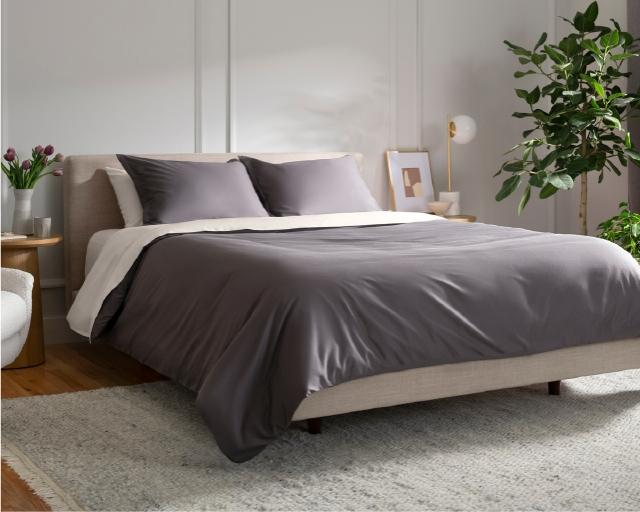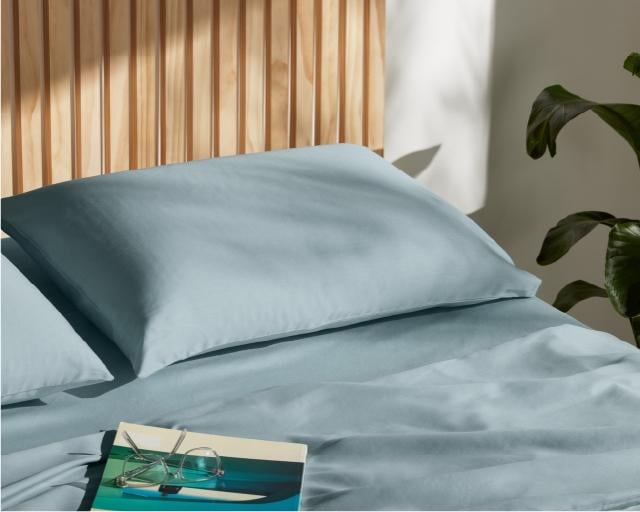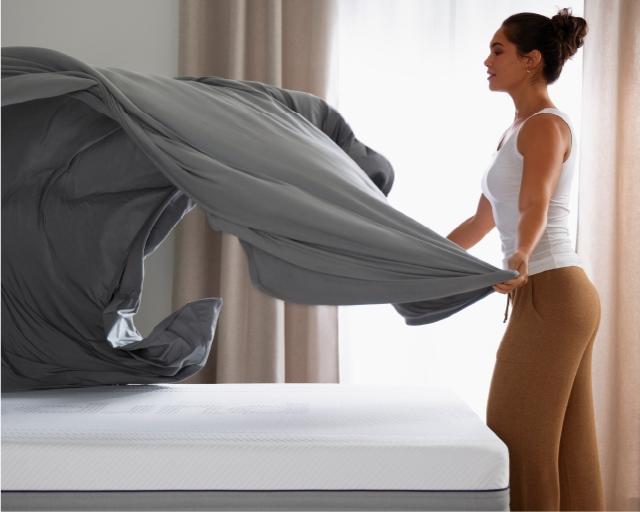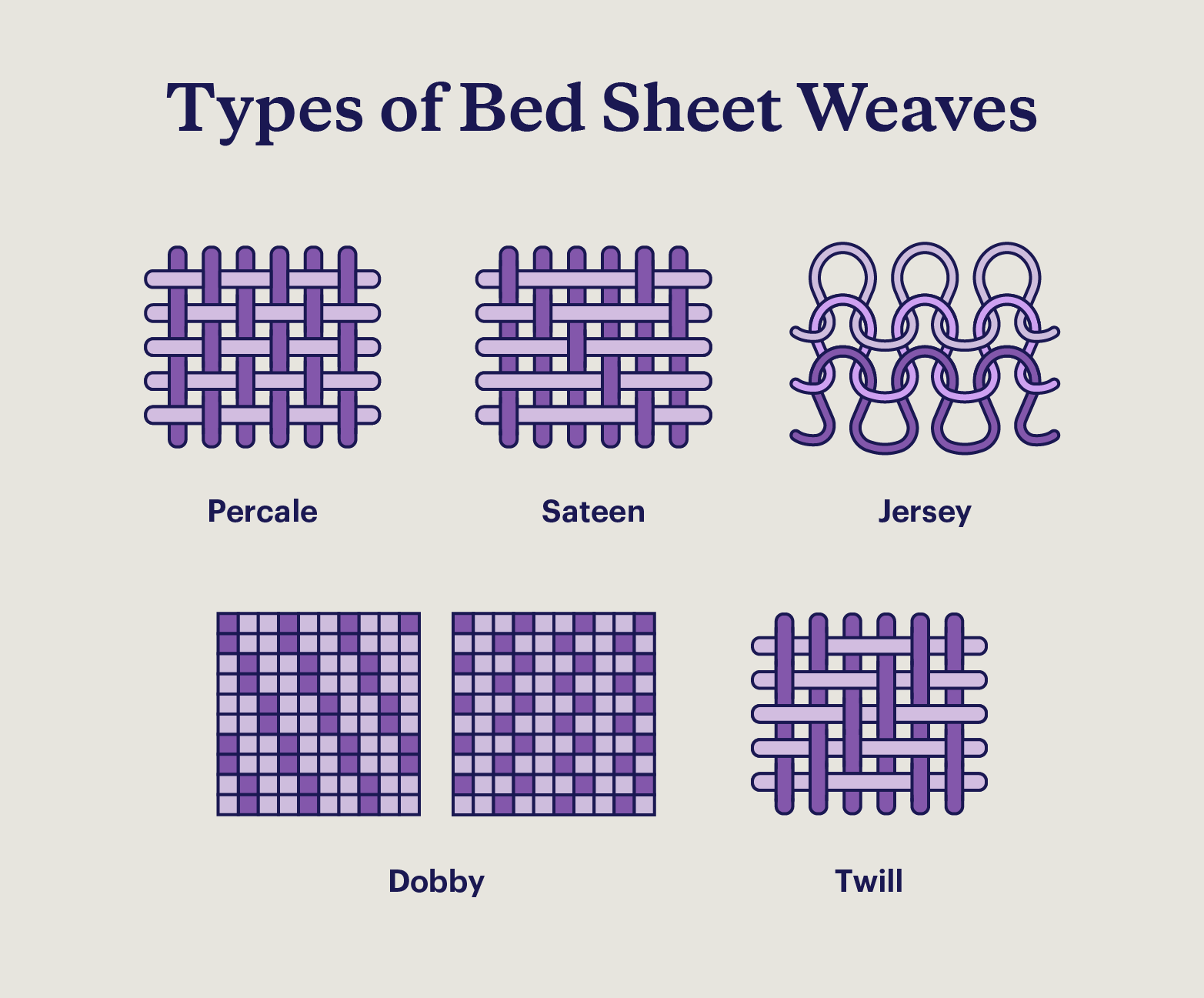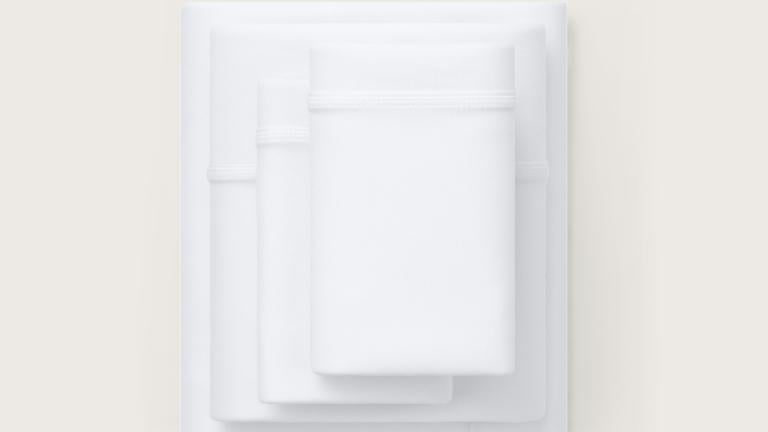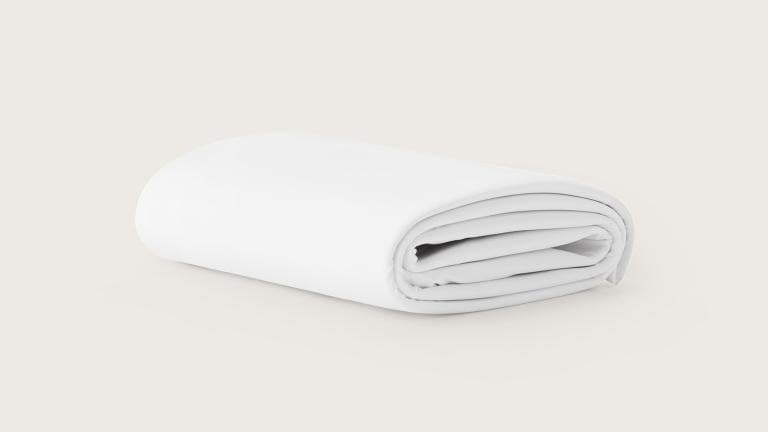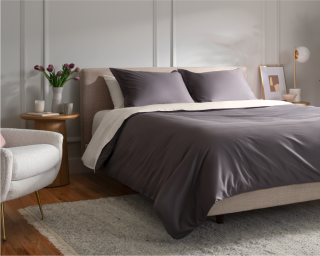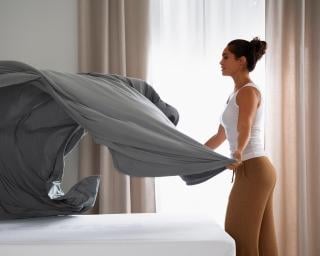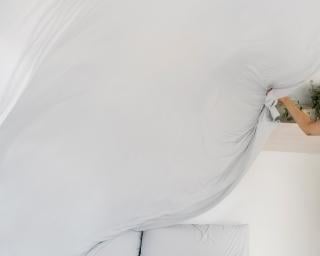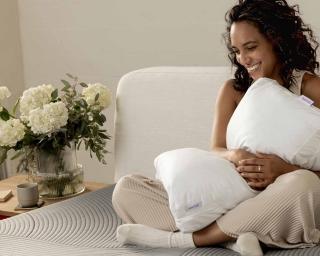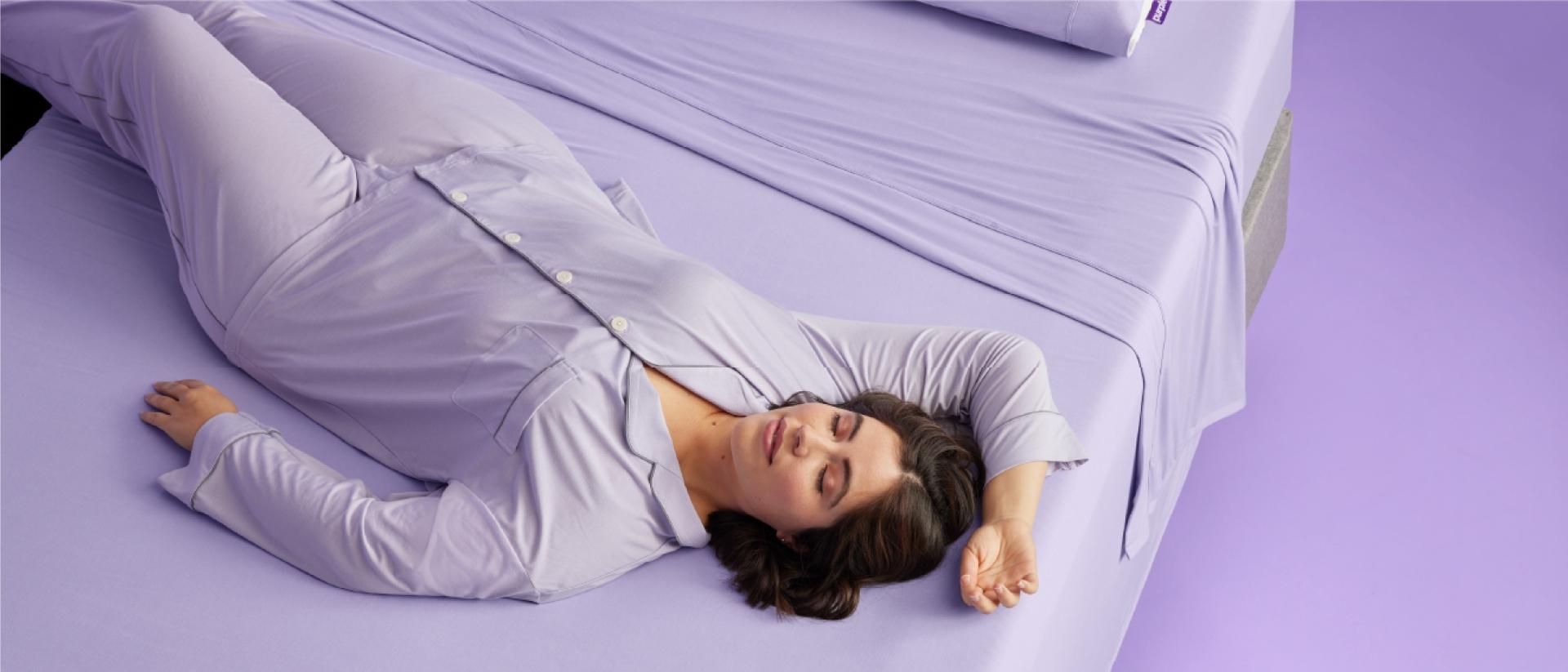
9 Types of Bed Sheets: Which Material Is Best for You?
The most common types of sheets include cotton, linen, bamboo, Tencel™, silk, satin, polyester, microfiber, and flannel. In addition to material, it’s important to consider factors such as weave, thread count, and feel.
While your mattress is the primary factor that affects the quality of your rest, bedding also plays a vital role. Knowing how to choose bed sheets that keep you comfortable begins by assessing all of your options and determining your preferences.
Before selecting your new sheets, learn the differentiating features between each option. From cotton to silk, there’s a myriad of options that each contain a unique set of pros and cons.
While there are certain quality standards for each type, there is no universal bed sheet material that is perfect for everyone. What you choose will depend on your preferences for factors like temperature, texture, softness, cost, bed sheet sizes, and care requirements. In this guide, we cover nine different types of bed sheets with information on material, weave, and thread count, as well as what to look for when considering which type is ideal for you.
Regardless of the type of bed linen you prefer, the quality, feel, and price will vary depending on the manufacturer. This necessitates the importance of either opting for a brand you trust or comparing similar options between different brands.
Sheet Type | Feel | Pros | Cons |
Cotton | Crisp or soft | Durable, breathable, softens over time | Prone to wrinkling |
Bamboo | Soft, smooth | Durable, breathable, naturally cooling | May be more expensive |
Linen | Crisp, cool | Breathable, softens after use | May be more expensive, may feel scratchy at first |
Tencel™ | Soft, silky | Naturally cooling, less likely to wrinkle | May be more expensive |
Silk | Smooth, cool | Best for skin and hair | May be more expensive, requires more care |
Satin | Smooth, cool | Cooling, good for skin and hair | May be more expensive, requires more care |
Polyester | Smooth, lightweight | Affordable, wrinkle-resistant | Synthetic, less breathable, sleeps hot |
Flannel | Soft, warm | Less likely to wrinkle, keeps you warm | Prone to pilling, not ideal for hot sleepers |
Microfiber | Soft, warm | Affordable, easy to care for | Synthetic, prone to pilling, sleeps hot |
1. Cotton
Cotton is the most common material used for bedding. This natural fiber is versatile, durable, and easy to clean. Cotton bed sheets are usually affordable and last a long time, making them a practical choice for most sleepers.
You can also choose from different kinds of cotton, which range in feel, quality, and price. Cotton sheets may feel stiff at first but tend to soften over time the more you wash them.
Organic Cotton
Ethically sourced and sustainably farmed, organic cotton is a great choice for environmentally conscious sleepers who want the smooth, breathable feel of cotton sheets. Organic cotton sheets are made from cotton grown without synthetic pesticides or fertilizers, making them an eco-friendly option.
Egyptian Cotton
Egyptian cotton is the highest-quality cotton available. Sheets made from Egyptian cotton are known to be thin and smooth with incredible durability. Because of their high quality, Egyptian cotton sheets are typically more expensive than other cotton options. Be aware that some manufacturers blend Egyptian cotton with other types of cotton to create more affordable sheets. Be sure to check the label to confirm the percentage of Egyptian cotton used.
Cotton Blends
Sheets made with a cotton blend combine cotton with other materials to improve durability and reduce costs. Common cotton blends feature polyester, linen, or wool.
Pima Cotton
Pima is a long-staple cotton known for its softness and durability. Pima sheets are less likely to wrinkle, making them a great low-maintenance option. Many hotels use Pima sheets because they are comfortable, long-lasting, and less prone to pilling than other cotton sheets.
Supima Cotton
Like Pima, Supima is known for its strong, extra-long cotton fibers that provide superior durability and softness. However, Supima specifically refers to this type of cotton grown only in the United States, accounting for under 1% of the global cotton market. Sheets made with Supima cotton are known to be exceptionally soft and durable.
If you’re looking for the softest bed sheets, most sources will point you to Supima, Pima, and Egyptian cotton options, but Purple’s bestselling SoftStretch® Sheets feature a silky soft feel with added stretch that allows you to feel the full comfort of your mattress.
American Upland Cotton
American upland cotton is the most commonly used cotton in the United States. Consisting of shorter fibers, American upland is a little coarser than Egyptian or Pima cotton, but sheets made with this type of cotton are much more affordable.
2. Bamboo
Bamboo bed sheets are a natural option with cooling, hypoallergenic, and antimicrobial properties, making them a great choice for sensitive skin. Bamboo grows quickly and needs few resources to thrive, making it a more sustainable material for a variety of products, including bed sheets and furniture.
The most common type of bamboo bedding is bamboo viscose or rayon, which refers to the process of extracting cellulose from bamboo stalks and turning the pulp into fabric. Sheets made from a bamboo blend contain both bamboo and other materials, such as cotton or polyester, making them less soft but more affordable.
3. Linen
Light and airy, linen is often used for summer or hot weather clothing. This makes linen bed sheets a great option for hot sleepers and warmer climates. This type of sheet usually feels stiff at first and will get softer and smoother over time. Linen sheets are also durable and can withstand ample washing.
4. Tencel™
Tencel™ is a brand name for lyocell, which refers to fabrics made out of wood pulp from eucalyptus trees. The process of creating lyocell fabrics entails recycling and repurposing any waste generated, making Tencel™ sheets another eco-friendly option.
Bed sheets made out of Tencel™ fabric are smooth and moisture-wicking, making them a great choice for hot sleepers. Tencel™ sheets are also less likely to wrinkle.
5. Silk
Silk is a natural fiber produced from silkworms. Spinning this fiber and weaving it into fabric is a labor-intensive process, making it one of the most expensive fabrics on the market. Often associated with luxury, silk is lightweight and smooth with a stunning sheen.
Silk sheets are cooling and naturally hypoallergenic, and their smoothness causes less friction than other fabrics, which can prevent frizzy and tangled hair. Often, sleepers will use silk pillowcases rather than a complete silk sheet set.
Because of how delicate the material is, silk sheets require much more care than other fabrics. Paired with the high price tag, few consumers prefer silk sheets for those reasons.
6. Satin
If you want the luxurious feel of silk without the labor-intensive care process and steep price tag, opt for satin sheets instead. Satin has a similar texture and sheen to silk but comes at a lower price. If you can’t get comfortable in bed because you’re too warm or your sheets cling to you as you shift, satin sheets may be an option worth trying.
7. Polyester
Polyester is a synthetic fiber that is long-lasting and affordable. While pure polyester sheets tend to be quite rough, they can be combined with other materials to create much softer polyester blends.
One of the most common polyester blends contains cotton. Cotton-polyester blends make for softer sheets that are sturdy, inexpensive, and easy to wash.
8. Flannel
Flannel is a loosely woven fabric, typically cotton or wool, that’s brushed to create a soft and fuzzy texture. This makes for cozy sheets and blankets — perfect for colder weather.
Like plaid flannel shirts, flannel sheets come in different patterns as well as solid colors. Generally, flannel sheets are easy to care for and tend to retain their softness over time.
9. Microfiber
Microfiber fabrics consist of tightly woven synthetic fibers, often a combination of polyester and nylon. While microfiber sheets may be more affordable than other options, they tend to be lower quality and are prone to pilling.
If you’re deciding between microfiber and cotton sheets, microfiber sheets are cheaper and easier to wash. However, you’ll have less variety with microfiber options, and they tend to be less breathable than cotton sheets.
Understanding Sheet Weaves
The materials used in your sheets impact their feel, but how those materials are woven together also affects softness, thickness, and durability. Depending on the weave, your sheets may feel crisp, smooth, soft, or textured. The most common weaves for sheets include percale and sateen, but there are a few other weaves to consider.
Weave | Description |
| Percale | A balanced cotton weave with a crisp, breathable feel allowing the most air flow |
| Sateen | An over-under cotton weave with a silky smooth texture |
| Jersey | Knitted (not woven) cotton with a soft, warm feel |
| Dobby | Woven on a dobby loom, featuring small geometric patterns for texture |
| Twill | A thicker weave with a diagonal pattern for a heavier, sturdier sheet |
Thread Count Meaning
Thread count refers to how many threads there are in a square inch of fabric. What’s the best thread count for sheets? It’s often said that the higher the thread count, the softer the sheets. But this isn’t always the case, especially with fabrics that are measured in a different way, such as silk, flannel, and microfiber. Manufacturers may not list thread counts because this measurement doesn’t always correlate with quality.
Silk is measured in momme, which accounts for how much silk by weight is present in a space of 100 yards by 45 inches, with 17-22 momme being ideal for silk sheets. Other materials, including flannel, microfiber, and jersey, are measured by weight, using grams per square meter (GSM) to assess quality.
In addition to thread count and similar measurements, you can also consider the ply of your sheets, which is how many fibers are used to form a single thread. Single-ply sheets, for example, use only a single fiber to create a thread. In most cases, double- or triple-ply sheets are actually rougher than one-play sheets because they combine cheaper materials.
Sheet Type | Thread Count/Grams Per Square Meter |
| Cotton | 300-600 |
| Egyptian cotton | 200-700 |
| Percale weave | 200-400 |
| Sateen weave | 250-300 |
| Bamboo | 250-500 |
| Twill | 200-400 |
| Tencel™ | 300+ |
| Linen | 80-150 |
| Polyester | 300-500 |
| Flannel | 170+ GSM |
| Jersey | 150 GSM |
| Microfiber | 90-120 GSM |
What Sheet Material Is Right for You?
Before you choose from different types of bed sheets, it’s important to consider your preferences. Here are a few things to ask yourself when choosing new bed sheets:
- What textures do you prefer? Some sleepers like smooth, soft sheets while others prefer thicker, warmer options.
- Are you a hot or cold sleeper? Flannel and jersey sheets will keep you warm, while cotton blends, bamboo, and TencelTM sheets are great for keeping cool.
- Do you have allergies? If so, you may want to choose hypoallergenic sheets to prevent flare-ups.
- Do you move around while you sleep? If you toss and turn, you’ll probably want smooth sheets rather than sheets that cling to you.
- What size do you need? Account for mattress thickness as well as the length and width of your bed.
- Which matters more: durability or comfort? You can find sheets that offer a combination of comfort and durability depending on your preferences.
- How do you want to wash and dry them? Some sheets have special care instructions, so be sure to check what’s best for the sheets you choose.
- Do you care about thread count or weave? Generally, a higher thread count means softer sheets, and the weave can affect how your bedding feels.
- How much do you want to spend on bedding? Materials like satin will be more costly than other fabrics like cotton or polyester.
Check out our flowchart for a full guide on buying bed sheets that meet your sleep needs.
Sleep Better With Purple
If you’re looking for breathable sheets that keep you comfortable and cool, Purple’s sheet sets are designed for temperature regulation and durability. We offer two types of bed sheets to suit your preferences: bamboo viscose and 100% cotton.
Our bed sheets work best with Purple mattresses, but they’re soft and comfortable no matter what mattress you use. Choose from Purple SoftStretch® sheets, made out of a silky-smooth bamboo blend that keeps you cool and dry at night, and our Complete Comfort sheet set, which features a breathable cotton-Spandex blend for added stretch.
Types of Sheets FAQ
The best type of bed sheet will vary from person to person. Factors such as temperature, sensitivities, allergies, the size of your mattress, texture preferences, and budget will all impact your decision.
Hot sleepers may prefer smooth, cool sheets made from materials like silk or bamboo. Choosing a breathable, moisture-wicking fabric like cotton can also keep you cool all year long.
Thick, warm sheets like flannel or polyester may be ideal in the winter, especially if you get cold easily and prefer a cozy bed.
If you tend to overheat, you may prefer a more breathable option like cotton or linen. Hot sleepers may not even need to swap out their summer sheets in the winter
Bed sheets typically include fitted and flat sheets as well as pillowcases. You’ll need to know what these sheets look like and how they fit before making your bed.
Your fitted sheet is the bottom layer, fitting around your entire mattress and mattress topper, if you have one. The flat or top sheet comes next, lying atop the fitted sheet and getting tucked in at the bottom and along the sides. Finally, your pillowcases slip over your pillows to protect them from discoloration and damage over time.
There is no one name for thick bed sheets, as these can be made out of different materials and weaves. For a thicker bed sheet, look for flannel sheets or a sateen weave, which uses a pattern of four threads over and one thread under.
More To Explore
Level up your sleep routine with our most-loved products.


